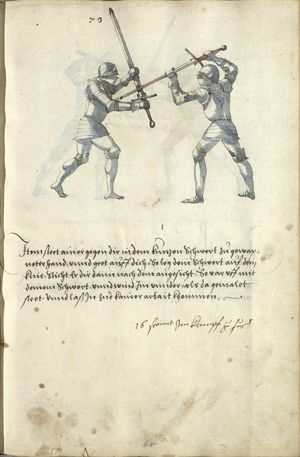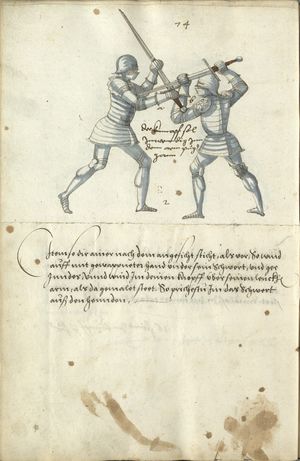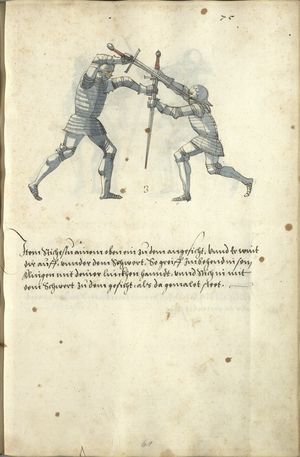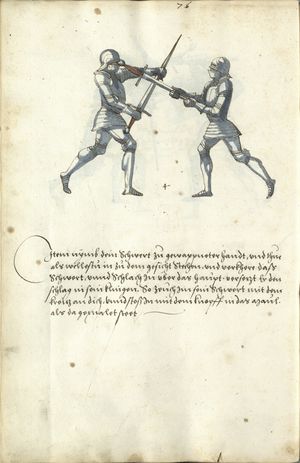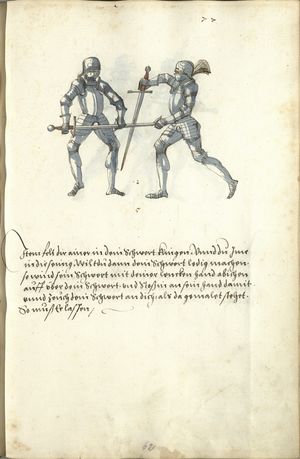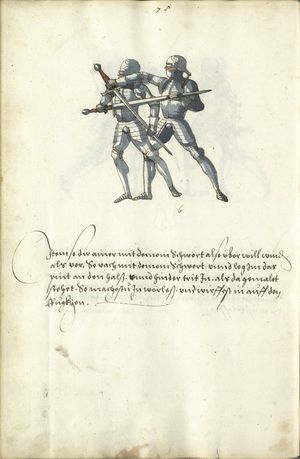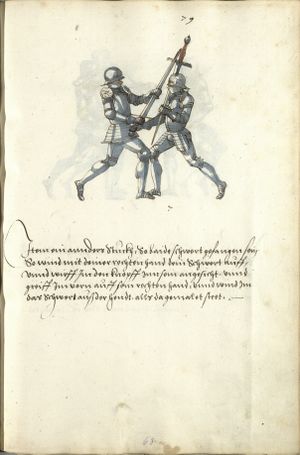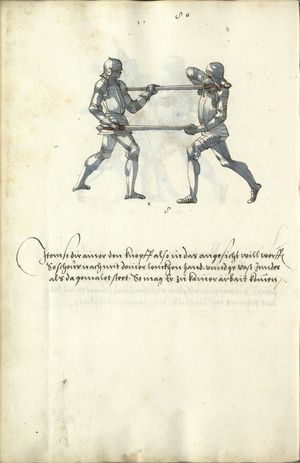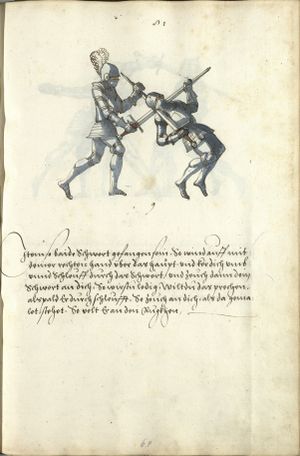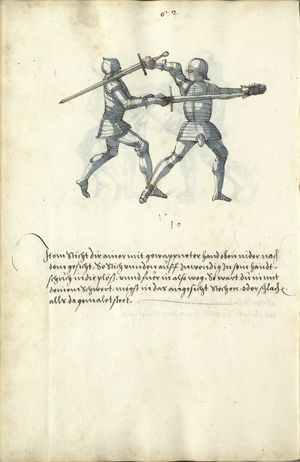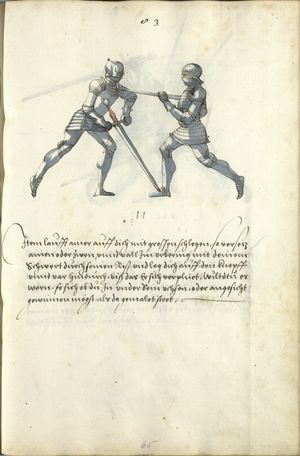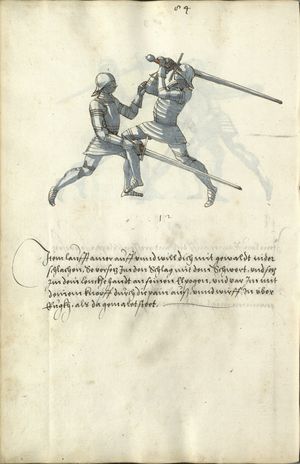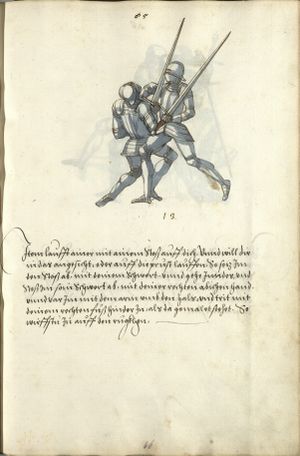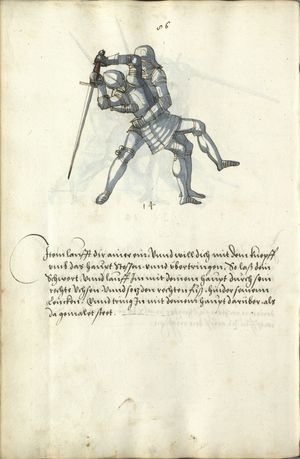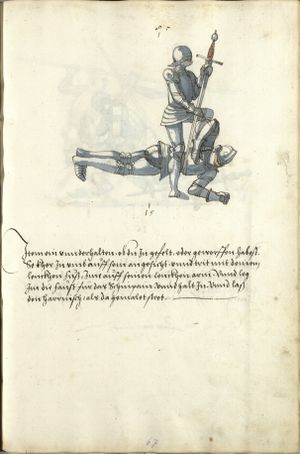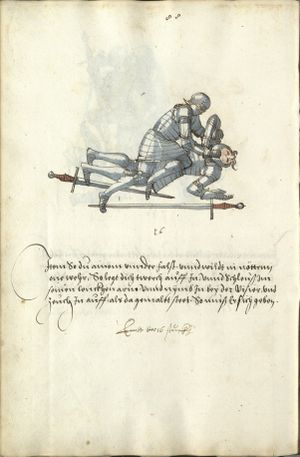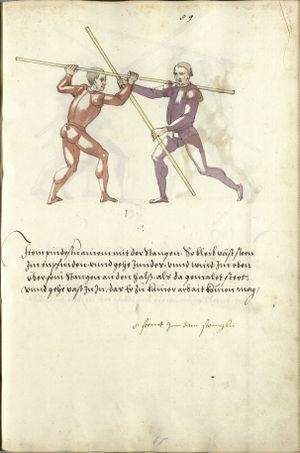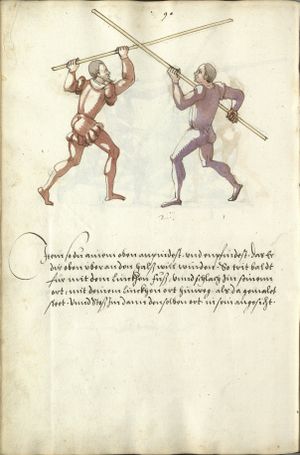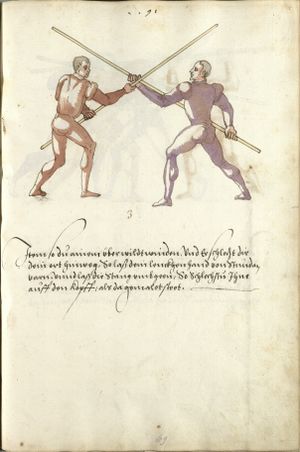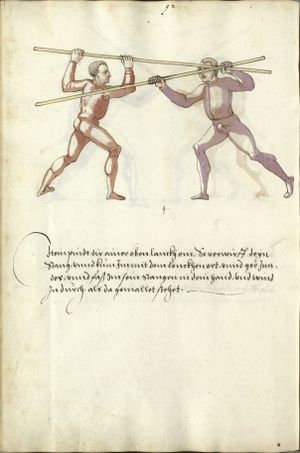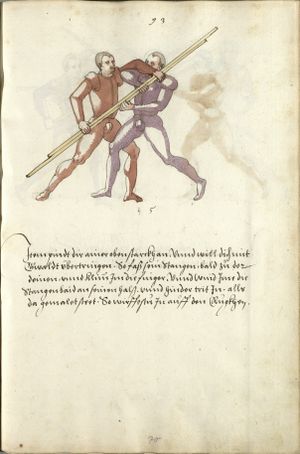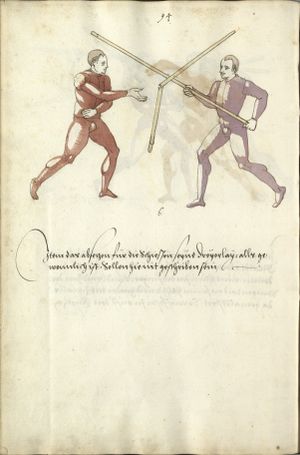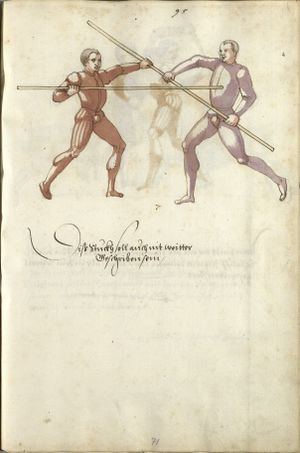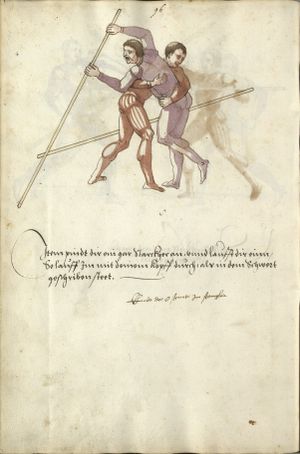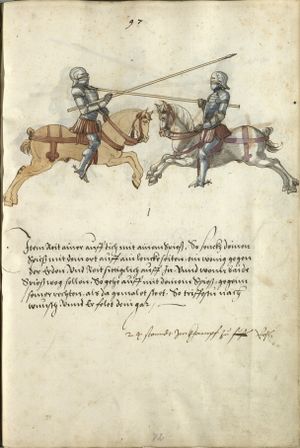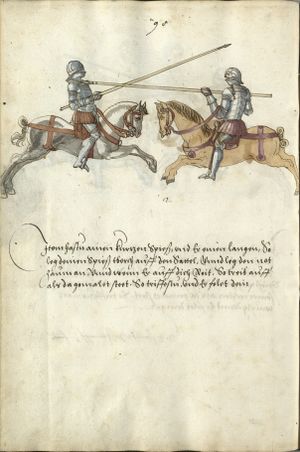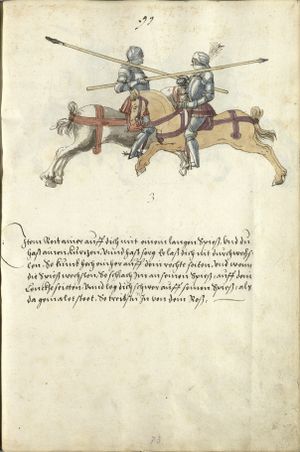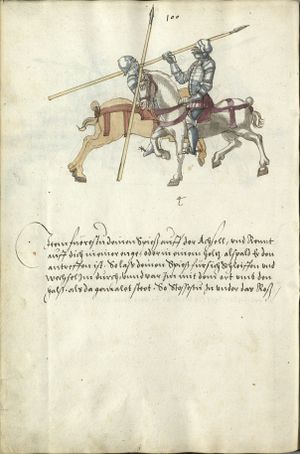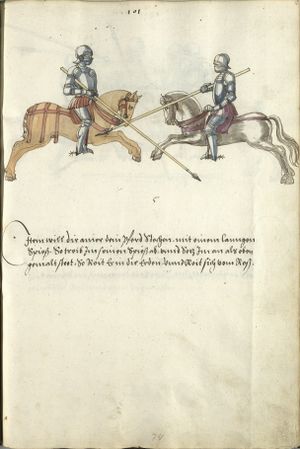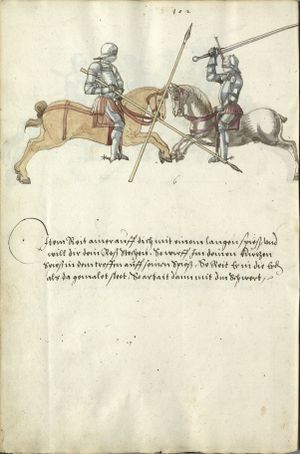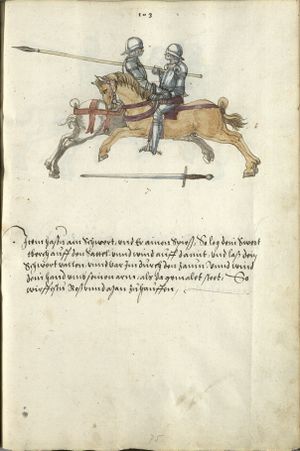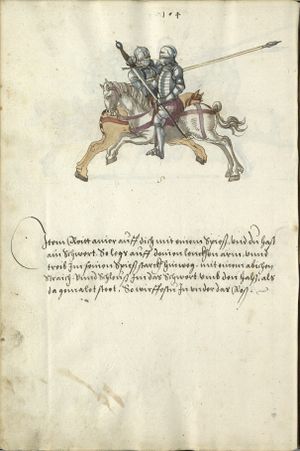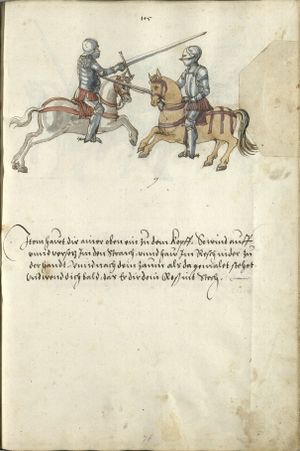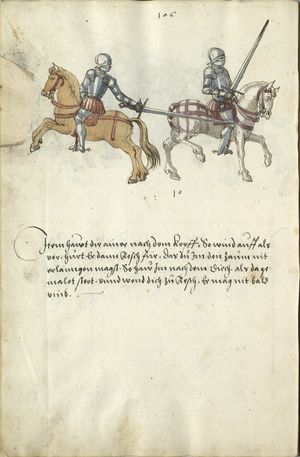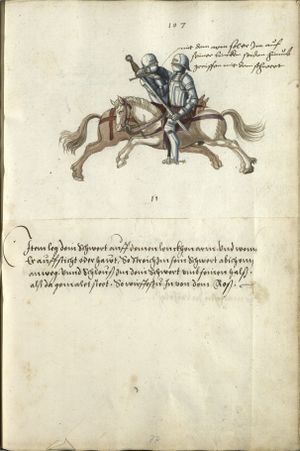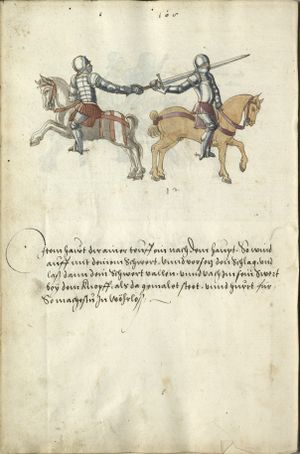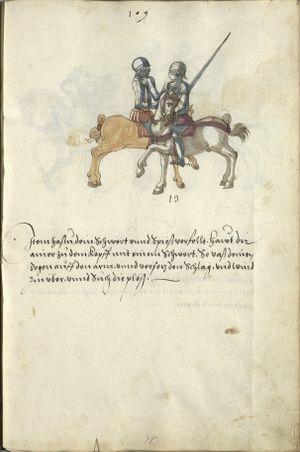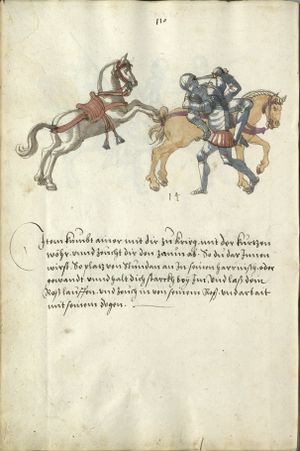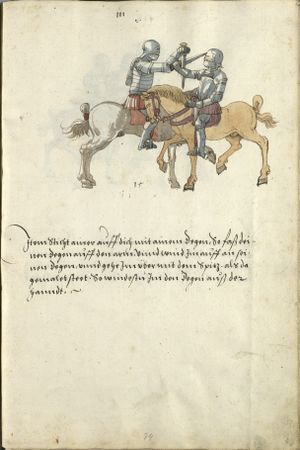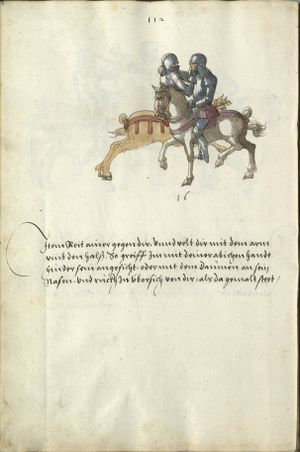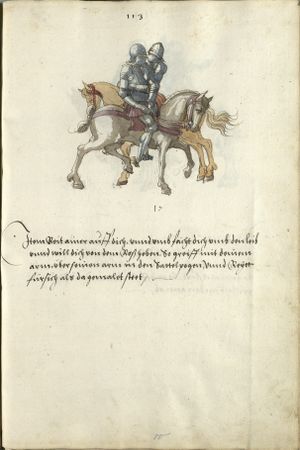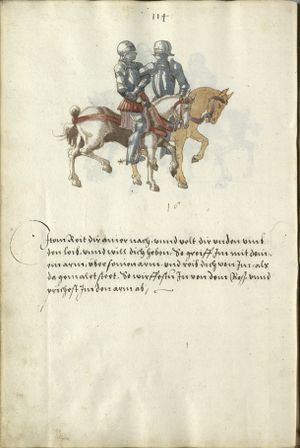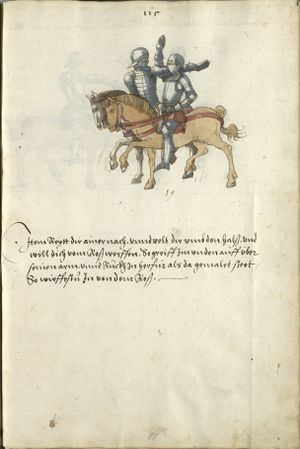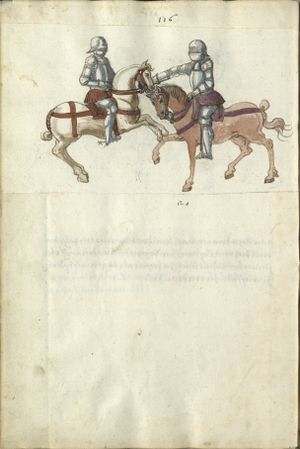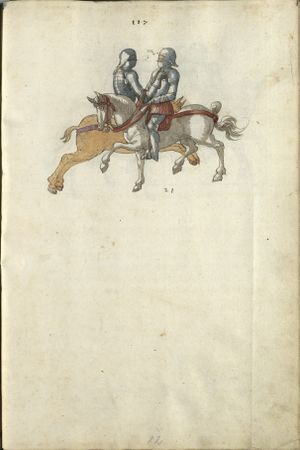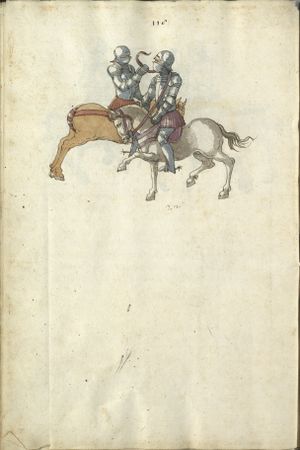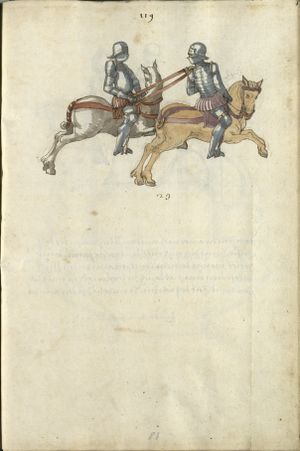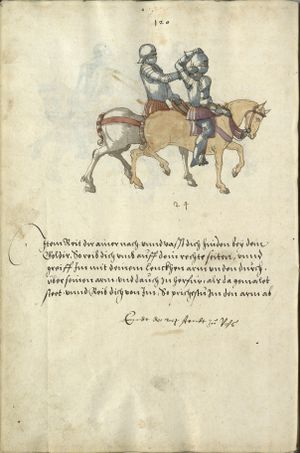|
|
You are not currently logged in. Are you accessing the unsecure (http) portal? Click here to switch to the secure portal. |
Difference between revisions of "Antonius Rast"
| Line 434: | Line 434: | ||
| {{paget|Page:Reichsstadt "Schätze" Nr. 82|080r|jpg|blk=1}} | | {{paget|Page:Reichsstadt "Schätze" Nr. 82|080r|jpg|blk=1}} | ||
| | | | ||
| − | | | + | | {{paget|Page:Cod.Guelf.1.6.3 Aug.2º|192v|png|lbl=192v3r}} |
| | | | ||
| | | | ||
Revision as of 04:17, 10 January 2019
| Antonius Rast | |
|---|---|
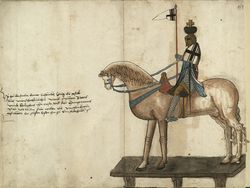 | |
| Born | ca. 1470s Nuremberg, Germany (?) |
| Died | 1549 Augsburg, Germany (?) |
| Occupation |
|
| Movement | Marxbrüder |
| Influences | |
| Influenced | Paulus Hector Mair |
| Genres | Fencing manual |
| Language | Early New High German |
| Archetype(s) | Currently lost (1540s) |
| Manuscript(s) |
Cod.Guelf.1.6.3 Aug.2º (ca. 1600)
|
Antonius Rast (ca. 1470s - 1549) was a 16th century German fencing master and Captain of the Marxbrüder fencing guild from 1522 to 1523. Paulus Hector Mair is the primary source of information about his life, noting that Rast was a professional sword polisher as well as a certified 'Master of the Long Sword'. He began work on a fencing manual later in his life, but didn't complete it before his death in 1549; Mair purchased the manuscript in 1552 and created a completed version in 1553.
Other than Mair's notes, there are no certain records of Rast's life. The chronicle of the Marxbrüder guild found in the Codex I.6.2º.5 mentions that an 'Anthoni Resch' was made Captain in 1522, and includes an 'Anthoni Rasch' in a list of Masters of the Long Sword in 1534. Both of these are presumed to be references to Rast, as they correspond well with Mair's account and texts from this time period have frequent misspellings, but this is by no means certain.
Rast's writings are consistent with the complex of manuals known as the Nuremberg Group, but since Paulus Hector Mair had access to the Codex Wallerstein when finishing Rast's treatise, it's difficult to make any statements about the nature of Rast's own teachings.
Contents
Treatise
The version of Rast's writings prepared by Mair includes sections on armored foot combat, unarmored staff fencing, and mounted combat, none of which appear in earlier sources and which may have been composed by Rast himself. However, a version of the mounted fencing material is included in the 1590s manuscripts of Jeremias Schemel von Augsburg, intermingled with those of Jörg Wilhalm Hutter; Schemel's manuscripts omit two of Rast's plays, but include captions for the devices on ff 78v-80r which are uncaptioned in Rast. Furthermore, several of them were reproduced in the German translation of Federico Grison's treatise on horsemanship printed in Augsburg in 1570. This may indicate that Rast was drawing on an earlier, unknown source for the mounted material, or even for all three of these sections.
That said, until such a source can be identified, all of the known versions will be compiled on this page.
Images |
Augsburg Version (1553)
| |
|---|---|---|
[057r] Item steet ainer gegen dir in dem kurzen schwert zu gewapneter hand. vnnd geet auff dich. so leg dein schwert dein knie. sticht er dir dann nach dem angesicht. so var vff mit deinem schwert. vnnd wind Im vnnder als da gemalet steet. vnnd laß In zur kainer arbait kommen. ~ | ||
[057v] Item so dir ainer nach dem angesicht sticht. als vor. so wind auff mit gewappneter hand vnder sein schwert, vnd gee Inndes. vnnd wind Im deinen knopff vber seinen lenckh(en) arm, als da gemalet steet. so prichstu Im das schwert auß den hennden. ~ d[er] k[nno?]pf ste Innwendig jm dem arm [prich?] J[?m][1] | ||
[058r] Item stichestu ainem oben ein zu dem angesicht. vnd er wint dir auff. vnnder dem schwert. so greiff Im behend in sei(n) [K?]rigen mit deiner linckhen hanndt vnnd stich [in] mit dem schwert zu dem gesicht. als da gemalet steet. ~ | ||
[058v] Item nymb dein schwert zu gewappneter handt. vnd thue als wellestu in zu dem gesicht stechen. vnd verkhere daß schwert vnnd schlach jn vber das haupt. verseczt er den schlag in sein klingen. so zeuch jm sein schwert mit dem kreicz an dich. vnnd stoß jn mit dem knopff in das maul als da gemalet steet. ~ | ||
[059r] Item felt dir ainer in dein schwert klingen. vnnd du jme in die seinig. wiltdu dann dein schwert ledig machen so wind sein schwert mit deiner lencken hand abichen auff vber dein schwert. vnd stoß in an sein hand damit vnnd zeuch dein schwert an dich. als da gemalet stehet. so muß er lassen. ~ | ||
[059v] Item so dir ainer mit deinem schwert also vber will wind als vor. so vach mit deinem schwert vnnd leg jm das [pint] an den halß. vnnd hinder trit In. als da gemalet stehet. so machestu jn wörloß vnd wirffest in auff de(n) rugkhen. ~ | ||
[060r] Item ain annders stuckh. so baide schwert gefangen sei(n) so wind mit deiner rechten hand dein schwert auff. vnnd wirff Im den knopff jnn sein angesicht. vnnd greiff jm vorn auff sein rechten hand. vnnd wind jm das schwert auß der handt. alls da gemalet steet. ~ | ||
[060v] Item so dir ainer den knopff also in das angesicht will werff(en) so scheus nach mit deiner lenckhen hand. vnnd ge vast Inndes als da gemalet steet so mag er zu kainer arbeit komen. | ||
[061r] Item so baide schwert gefangen sein. so wind auff mit deiner rechten hand vber das haupt vnd ker dich vmb vnnd schleuff durch das schwert vnd zeuch dann dei(n) schwert an dich. so wirstu ledig. wiltdu das prechen. alspald er durch schleufft. so zeuch an dich. als da gemalet stehet. wo velt er an [sic] de[n] rugkhen. ~ | ||
[061v] Item sticht dir ainer mit gewappneter hand ob nider nach dem gesicht. so stich vnnden auff jnwendig jn sein handt. schu[ch] in die plöß. vnnd fuer in also weg. so wart du in mit deinem schwert. m[ö]gst in das angesicht stechen oder schlach(en) alls da geamalet steet. ~ | ||
[062r] Item laufft ainer auff dich mit grossen schlegen so versecz ainen oder zwen vnnd vall jm vrbering mit deinem schwert durch seinen [Riß] vnd leg dich auff den knopff vnnd var hindurch. biß das er sich verpluet. wiltdtu es wern. se sich ob du In vnder sein vchsen. oder angesicht gewinnen mögst als da gemalet steet. ~ | ||
[062v] Item laufft ainer auff vnnd will dich mit gewaldt nider schlachen. so versecz Im den schlag mit dem schwert und secz Im dein lenkhe handt an seinen elpogen vnd var jm mit deinem knopff durch die pain auß vnnd wirff jn vber Rugkh. als da gemalet steet. ~ | ||
[063r] Item laufft ainer mit ainem stoß auff dich. vnnd will dir in das angesicht. oder auff die prust lauffen. so secz Im den stoß ab. mit deinem schwert. vnnd gehe Inndes vnd stoß jm sein schwert ab. mit deiner rechten abichen hand vnnd var Im mit dem arm vmb den hals. vnd trit mit deinem rechtn fuß hinder jn. als da gemalet stehet. so wirffstu jn auff den rugkhen. ~ | ||
[063v] Item laufft dir ainer ein. vnnd will dich mit dem knopff vmb das haupt stossen. vnnd vbertringen. so laß dein schwert vnnd lauff Im mit deinem haupt durch sein rechte vchsen. vnnd secz den rechten fuß. hinder seinenn lincken. vnnd tring In mit deinem haupt darüber. als da gemalet steet. ~ | ||
[064r] Item ain vnderhalten. ob du In gefelt. oder geworffen habest so kher In vmb auff sein angesicht. vnnd trit mit deinem lenckhen fuß. Ime auff seinen lenckhen arm. vnnd leg Im die faust fur das schinpain. vnnd halt In. vnnd laß den harrnisch als da gemalet steet. ~ | ||
[064v] Item so du ainem vnder halst vnnd wildt in [nötte(nn)] one wehr. so legt dich twerch auff. In vnnd schleuß jm seinen lenckhen arm. vnnd nymb in bey der [visier] vnd zeuch In auff als da gemalet steet. so muß er sich geben. |
Images |
Augsburg Version (1553) | |
|---|---|---|
[1] Mark, one binds you with the staff, then remain firmly standing in the feeling, and go meanwhile and wind in above over his staff on the neck, as here depicted stands, and go fast in that he may not come to work. |
[065r] Item pindestu ainem mit der stangen. so bleib väst steen Im enpfinden. vnnd gehe Inndes. vnnd wind Im oben vber sein stangen an den halß. als da gemalet steet. vnnd gehe vast In jn. das Er zu kainer arbait komen mag. | |
[2] Mark, then one binds-on you above, and you feel that he will wind above over on the neck, then step quickly forwards with the left foot and strike his point away with your left point, as here depicted stands, and thrust the same point in his face. |
[065v] Item so du ainem oben anpindest. vnd enpfindest. das Er dir oben vber an den halß will winden. so trit baldt für mit dem linckhen fuß. vnnd schlach jm seinenn ort. mit deinem linckhen ort hinweg. als da gemalet steet. vnnd stoß Im dann denselben ort in sein angesicht. | |
[3] Mark, then you will wind one above, and he strikes your point away, then let your left hand drive from the staff, and let the staff go around, then you strike him on the head, as here depicted stands. |
||
[4] Mark, one binds you above in long, then throw your staff and come in with the left point, and meanwhile go and grasp his staff in your hand, and wind through him, as here depicted stands. |
[066v] Item pindt dir ainer oben lanckh ein. so verwirff deyn stang. vnnd kum Im mit dem lenckhen ort. vnnd gee Inn. des. vnnd faß jm sein stangen in dein hand. vnd wind Jn durch. als da gemallet stehet. ~ | |
[5] Mark, one binds on you above strongly, and will force you over with strength, then grasp his staff quickly to yours and clamp his fingers, and wind the staff in quickly on his neck. Wind, step behind him, as here depicted stands, then you throw him on the back. |
[067r] Item pindt dir ainer oben starckh an. vnnd will dich mit Gwaldt vbertringen. so faß sein stangen. bald zu der deinen. vnnd klim Im die finger. vnnd wind Ime die stangen baid an seinen halß. wind hinder trit In. alls da gemalet steet. so wirffestu In auff den Ruckhen. | |
[6] Mark, the setting-offs for the shooting are of three sorts, as is customary, they shall not be described here. |
[067v] Item das abseczen fur die schiessen seynd dreyerlay. alls gewounlich ist. sollen hie nit geschriben sein. ~ | |
[7] This technique shall additionally also not be described. |
||
[8] Mark, one binds on you very strongly and runs in on you, so run meanwhile with your head through, as stands described in the sword. End the 8 standings in staff |
[068v] Item pindt dir ein gar starckher an. vnnd laufft dir einn so lauff Im mit deinem kopff durch. als in dem schwert geschriben steet. ~ [barely legible] Enndt der 8 stennd jm stenglin |
Images |
Augsburg Version (1553) |
Vienna Transcription (ca. 1600) |
Wolfenbüttel I Transcription (ca. 1600) |
Wolfenbüttel II Transcription (ca. 1600) |
||
|---|---|---|---|---|---|---|
[069r] Item reit ainer auff dich mit ainem spieß. So senckh deinen spieß mit dem ort auff ain lencke seiten. ein wenig gegen der erden. und. reit sittiglich auff In. vnnd wenn baide spieß weg sollen. So gehe auff mit deinem spieß. gegenn seiner rechten. als da gemalet steet. So triffstu nach wunsch. vnnd er felet dein gar. ~ |
||||||
[069v] Item hastu ainen kurczen spieß. vnd er ainen langen. so leg einen spieß tberch auff den sattel. vnnd leg den not zaum an. vndd wenn er auff dich reit. so treib auff als da gemalet steet. so triffestu. vnd er felet dein. |
||||||
[070r] Item rait ainer auff dich mit einem langen spieß vnd du hast ainen kurczen. vnnd hast sorg er laß dich nit durchwechs len. so kumb hoch einher auff dein rechte seiten. vnd wen(n) die spieß wechslen. so schlach jm an seinen spieß auff dein lenckhe seitten. vnnd leg dich schwer auff seinen spieß. als da gemalet steet. so treibstu in vor de[in] Roß. ~ |
||||||
[070v] Item fuerestu deinen spieß auf der Achsell. vnd Kommt auff dich in ainer enge. oder in einem holz alspald er den antreffen ist so laß deinen spieß fursich schleiffen vnd wechsel jm durch. vnnd var Im mit dem ort vmb den hals. als da gemalet steet. so stossestu in vnder das Roß. |
||||||
[071r] Item will dir ainer dein pferd stechen. mit einem lanngen spieß. so treib Im seinen spieß ab vnnd secz Im an als oben gemalet steet. so reit er in die Erden. vnnd reit sich vom Roß. |
||||||
[072r] Item hastu ain schwert. vnd er ainen spieß. so leg dein swert [sic] tberch auff den sattel vnnd wind auff damit vnd laß dei(n) schwert vallen vnnd var Im durch den zaum. vnnd wind dein hand [vmb] seinen arm. als da gemalet steet. so wirffestu roß vnnd man zu hauffen. ~ |
||||||
[072v] Item reit ainer auff dich mit einem spiess vnd du hast ain schwert. so legs auff deinen lenckhen arm. vnnd treib Im seinen spieß starckh hinweg. mit einem abiche(n) straich. vnnd schleuß Im das schwert vmb den hals. als da gemalet steet. so wirffestu In vnder das roß. ~ |
||||||
[073r] Item hawt dir ainer oben ein zu dem kopff. so wind auff vnnd versecz Im den straich. vnnd haw Im resch nider zu der handt. vnnd nach dem zaum als da gemalet stehet [vnd] wend dich bald. das er dir dein Roß nit stech. ~ |
||||||
[073v] Item hawt dir ainer nach dem kopff. so wind auff als vor. hurt er dann resch fur. das du Im den zaum nit erlanngen mags. so haw Im nach dem [dierh] als da gemalet steet. vnnd wend dich zu resch. er mag nit bald vmb. ~ |
||||||
[074r] mit dem arm sol er jm auf [seinen] linken peiden hennd greipfen mit dem schwert Item leg dein schwert auff deinen lenckhen arm. vnd wen(n) er auff sticht oder hawt. so straich Im sein schwert abichen(n) anweg. vnnd schleuß jm dein schwert vmb seinen halß. alß da gemalet steet. so wirffestu In von dem Roß. ~ |
||||||
[074v] Item hawt dir ainer [teuff?] ein nach dem haupt. so wind auff mit deinem schwert. vnnd versecz den schlag. vnd laß dann dein schwert vallen. vnnd vach jm sein swert [sic] bey dem knopff. als da gemalet steet. vnnd hurrt fur so machestu In wöhrloß ~ |
||||||
[075r] Item hastu dein schwert vnnd spieß verfellt. hawt dir ainer zu dem kopff mit ainem schwert. so vaß deinen Degen auff den arm. vnnd versecz den sclag. vnd wind jm vber. vnnd such die plöß. ~ |
||||||
[075v] Item kumbt ainer mit dir zu krieg. mit der kurczen wöhr. vnnd zeucht dir den zaum ab. so du das Innen wirst. so placz von stundan an In seinen harrnisch. oder gewandt. vnnd halt dich starckh bey Im. vnd laß dein Roß lauffen. vnd zeuch in von seinem Roß vnd arbait mit seinem Degen. ~ |
||||||
[076r] Item sticht ainer auf dich mit ainem Degen. so faß dienen Degen auff den arm. vnnd wind Im auff an seinen Degen. vnnd gehe Im vber mit dem spiecz. als da gemalet steet. so windestu Im den auß der handt. ~ |
||||||
[076v] Item reit ainer gegen dir. vnnd velt dir mit dem arm vmb den halß. so greiff Im mit deiner abichen handt hinder sein angesicht. oder mit dem Daumen an sein nasen. vnd ruckh jn vbersich von dir als da gemalt steet. |
||||||
[077r] Item reit ainer auff dich vnnd vmb facht dich vmb den leib vnnd will dich von dem Roß heben so greiff mit deinem arm. vber seinen arm in den sattelpogen. vnnd reytt für sich als da gemalet steet. ~ |
||||||
[077v] Item reit dir ainer nach. vnnd velt dir vnden vmb den leib. vnnd will dich heben. so greiff Im mit deinem arm vber seinen arm vnd reib dich von Im als da gemalet steet. so wirffestu In von dem Roß vnnd prichest Im den arm ab. ~ |
||||||
[078r] Item reytt dir ainer nach. vnnd velt dir vmb den halß. vnd will dich vom roß werffen. so greiff im vnden auff vber seinen arm. vnnd ruckh jn [herfur] als da gemalet steet so wirffestu in von dem roß. ~ |
[213v4r] Item Reitt dir ainer nach und felt dir umb denn hals, und wil dich vom Roß werffen, so greiff Im unden auff uber seinen Arm, und Ruckh Inn herfur als da gemalt steet, So wirfst du Inn vom Roß. |
[216v7r] Item Reitt dir ainer nach, und feltt dir umb denn hals, und will dich vom Roß werffen, so gre[i]ff Im undenn auff Iber seinen Arm, und Ruckh Inn herfur, als da gemalet stett, [s]o wirfst du Inn vom Roß. |
||||
[078v] [No text] |
[215v6r] Item so zwen gegen ain ander Reitten, also Ergreifft dan ainer des andern pferd bei dem zaum, zeucht damit man und Roß zu Im, undergreifft in mit seinem Rechten arm des anderen schwech, wurff in also vom pferdt, wie hie gemalet steet. |
[218v9r] Item so zwen gegen ain ander Reitten, also ergreifft dann ainer des andern pferd bei dem zaum, zeucht damit man und Roß zu Im, und ergreifft in mit seinem Rechten arm, des andern schwech, wurfft Inn also vom pferd wie hie gemalet stett. |
||||
[079r] [No text] |
[217v8r] Item so zwen gegen ain ander Rennen, ainer den andern vom pferdt zu fellen, in dem er wist der ain dem andern des pferdts zigel, damit man unnd pferdt an sich zeichen also ergreifft der ander hin Iber ain zigel ledig zu machen In dem greifft der ander under den zigel hinauff an des andern prust wurfft Inn damit vom pferdt. |
[220v1r] Item so zwen gegen ain ander Rennen, ainer denn andern vom pferdt zu fellen, In dem er wist der ain dem andern däs pferts zigel damit man und pferdt an sich zu zeichen, also ergreifft der ander hin Iber ain zigel ledig zu machen, In dem greifft der ander under den zigel hin auff an des andern prust wurfft Inn damit vom Pferdt. |
||||
[079v] [No text] |
[219v20r] Item so zwen gegen ain ander Rhennen, ainer den andern vom pferdt zu fellen, so ergreifft der ain des andern zigel vom pferdt, wirfft In umb des andern hals, und mit seiner lincken fast er des andern rechten hand, nimbt in damit gefangen, wie hie gemalet steet. |
[222v3r] Item so zwen gegen ain ander Rennen, ainer denn andern vom pferdt zu fellen, so ergreiff der ain des andern zigel vom pferdt, wirfft Inn umb des andern hals, unnd mit seiner lincken fast er des andern Rechten hand, Nimpt Inn damit gefangen, wie hie gemalet steet. |
||||
[080r] [No text] |
[192v3r] Item so zwen mit ain ander zu Roß kempffen und der ain begert zu weichen, so hatt der ander ain Instrument vornen mit ainem, hackhen, wirfft denn andern hinden Inn der flucht ann sein hals, Reist Inn damit com pferdt, Wie hie gemalet stett. |
|||||
[080v] Item reit dir ainer nach vnnd vasst dich hinden bey dem Goldir. so reib dich vmb auff dein rechte seiten. vnnd greiff im mit deinem lenckhen arm vnden durch. vber seinen arm vnd dauch in herfur. als da gemalet steet. vnnd reib dich von Im so prichestu jm den arm ab. |
[221v2r] Item Reitt dir ainer nach und fast dich hinden bei dem hals, so reib dich umb auff dein Rechte seitten, und greiff Im mit deinem linckhen arm, unden durch uber seinen arm, und dauch In herfur, als da gemalt steet, und Reib dich von Im, So brichst du Im denn arm. |
[224v5r] Item Reitt dir ainer nach und fast dich hinden bei dem hals, so Reib dich umb auff dein Rechte seitten, unnd greiff Im mit deinnem lincken arm unden durch, uber seinnen arm, unnd dauch Inn herfur als da gemalett steett, unnd Reib dich vonn Im, so brichst du Im denn Arm. |
For further information, including transcription and translation notes, see the discussion page.
| Work | Author(s) | Source | License |
|---|---|---|---|
| Images | Stadtarchiv Augsburg | WikiMedia Commons | |
| Translation | |||
| Transcription | Werner Ueberschär | Index:Rast Fechtbuch (Reichsstadt "Schätze" Nr. 82) |
Additional Resources
References
- ↑ Zwischen der Abbildung der Kämpfer ist hier ein Text eingefügt, auf Vorlage schwer lesbar, von anderer Hand.
- ↑ „von stangen varn“ würde hier eigentlich mehr Sinn ergeben. Gegen ein „u“ spricht der fehlende Umlaut. „nn“ würde aber keinen Sinn ergeben. Die letzte Silbe könnte auch ein „er“ sein.
- ↑ Man könnte fast meinen, der Schreiber verliert langsam die Lust ;-)
- ↑ Vermutl. hat hier der Schreiber das „e“ vergessen.

